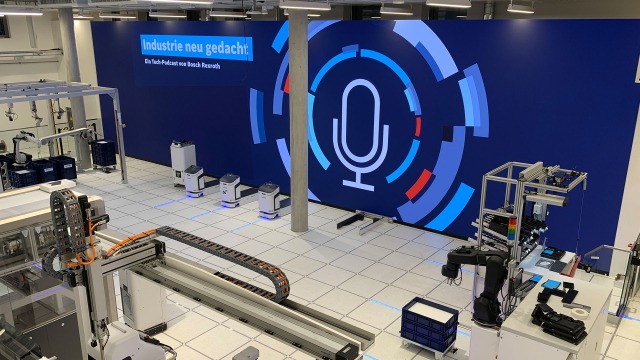



AGVs (Automated Guided Vehicle) and AMRs (Autonomous Mobile Robots) make material transport in your production or logistics ready for the future. New technologies and the demands of Industry 4.0 are creating a real boom in these mobile robots, also known as AGV's (Automated Guided Vehicles). In this episode of the Tech Podcast, Mark Grötzinger talks about the state of the art as well as application scenarios for the future.

What does the market need? Based on use cases in its own domain, Bosch Rexroth has developed a driverless transport vehicle.
AGV (Automated Guided Vehicle): AGVs perform material handling tasks automatically without human intervention, but require external physical infrastructure for navigation and localisation on all routes.
AMR (Autonomous Mobile Robot): AMRs also perform material handling tasks automatically without human intervention. Typically, AMRs use integrated SLAM-based navigation for localisation. You can find the podcast on the AMR ActiveShuttle here.
Why did Bosch Rexroth actually develop an AGV? In the tech podcast, Mark Grötzinger explains how know-how about production logistics inspired him and his team to improve material flow. "We focused the development on a clearly defined use case and are now bringing it to market" - and based on this, the development for new use cases continues.
Compared to a classic conveyor system, the AGV already scores with numerous strengths: As a dynamic transport system, material can be moved quickly from A to B - and shortly afterwards from B to C, D to A, etc. And this is done purely by software, without mechanical changes. In addition, faster, individual transports make waiting times obsolete and thus facilitate production in batch size 1.
But the AGV is also a driver in other aspects of the factory of the future. On the one hand, for example, AGVs are quicker and easier to install at new production sites than fixed systems. On the other hand, they enable new concepts such as leasing models - the podcast discussion goes even further and does not even stop at Robotic-as-a-Service.
The AGVs are orchestrated via the ActiveShuttle Management System (AMS). Here, sources and sinks are defined, charging stations, restricted zones and much more are mapped. Mark Grötzinger has made "Plug & Go" his motto: "For us, it's very important: it has to be easy and the customer has to be able to do it himself." In the rest of the interview he also explains how the installation works, how easily other robots can be added and what use cases he sees for AGVs in the future.
You can find this and more episodes on the factory of the future in our tech podcast channel "Industry rethought" on all known platforms or you can subscribe directly here via Podigee.
Contact person for the Bosch Rexroth Tech Podcast: Susanne Noll
Please feel free to contact Bosch Rexroth!